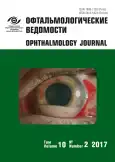Анализ результатов лечения пациентов с синдромом «сухого глаза» бесконсервантными глазными каплями 0,3 % раствора гиалуроната натрия после факоэмульсификации
- Авторы: Пирогов Ю.И.1, Бутина Г.М.1, Оксентюк А.А.1, Хромова Е.С.1
-
Учреждения:
- Медицинский центр АО «Адмиралтейские верфи»
- Выпуск: Том 10, № 2 (2017)
- Страницы: 73-77
- Раздел: Статьи
- URL: https://journals.rcsi.science/ov/article/view/6745
- DOI: https://doi.org/10.17816/OV10273-77
- ID: 6745
Цитировать
Полный текст
Аннотация
Послеоперационный синдром «сухого глаза» встречается у значительной части пациентов после факоэмульсификации. Его появление объясняется операционной травмой и применением глазных капель, содержащих консерванты. У ряда больных он вызывает существенный дискомфорт, не стихающий спустя 3–4 недели после операции.
Цель — исследование результатов применения глазных капель 0,3 % раствора натриевой соли гиалуроновой кислоты для лечения синдрома «сухого глаза» у пациентов после факоэмульсификации.
Материалы и методы. Изучены базальная секреция слёзной жидкости (проба Ширмера II) и время разрыва слёзной плёнки (проба Норна) у 33 больных, предъявляющих жалобы, характерные для синдрома «сухого глаза», через 1 месяц после факоэмульсификации. Этим пациентам в оперированный глаз назначали 30-дневный курс закапывания бесконсервантного 0,3 % раствора гиалуроновой кислоты, после чего пробы Ширмера II и Норна повторяли. Динамику субъективного состояния изучали на основании балльной оценки по шкале опросника OSDI.
Результаты. Средние значения исходных данных базальной секреции слёзной жидкости и времени разрыва слёзной плёнки были несколько ниже нормы. Через 1 месяц после применения оказалось, что показатель стабильности слёзной плёнки (по Норну) на фоне использования «Гилан Ультра Комфорт» стал несколько лучше: среднее значение времени разрыва слёзной плёнки — 9,8 ± 2,5 с. Оценка жалоб пациентов по опроснику OSDI также выявила наличие у больных признаков лёгкой степени тяжести ксероза. Среднее значение баллов до лечения составило 19,6 ± 10,0. Положительную динамику процесса после применения препарата «Гилан Ультра Комфорт» подтверждает достоверное уменьшение количества баллов по шкале OSDI до 12,3 ± 6,3.
Полный текст
Открыть статью на сайте журналаОб авторах
Юрий Иванович Пирогов
Медицинский центр АО «Адмиралтейские верфи»
Автор, ответственный за переписку.
Email: visus1@yandex.ru
заведующий офтальмологическим отделением
Россия, Санкт-ПетербургГалина Михайловна Бутина
Медицинский центр АО «Адмиралтейские верфи»
Email: Galinabutina@mail.ru
врач-офтальмолог
Россия, Санкт-ПетербургАлександр Анатольевич Оксентюк
Медицинский центр АО «Адмиралтейские верфи»
Email: os753@yandex.ru
врач-офтальмолог
Россия, Санкт-ПетербургЕкатерина Сергеевна Хромова
Медицинский центр АО «Адмиралтейские верфи»
Email: gubaidullina90@mail.ru
врач-офтальмолог
Россия, Санкт-ПетербургСписок литературы
- Астахов С.Ю., Ткаченко Н.В. Эффективность трегалозы в лечении синдрома «сухого глаза» после факоэмульсификации // Офтальмологические ведомости. – 2016. – Т. 9. – № 4. – С. 79–89. [Astakhov SYu, Tkachenko NV. Trehalose efficacy in dry eye syndrome treatment after phacoemulsification. Oftal’mologicheskie vedomosti. 2016;9(4):79-89. (In Russ.)]. doi: 10.17816/OV9479-89.
- Бржеский В.В., Егорова Г.Б., Егоров Е.А. Синдром «сухого глаза» и заболевания глазной поверхности: клиника, диагностика, лечение. – М.: ГЭОТАР-Медиа, 2016. – 464 с. [Brzheskiy VV, Egorova GB, Egorov EA. Sindrom “sukhogo glaza” i zabolevaniya glaznoy poverkhnosti: klinika, diagnostika, lechenie. Moscow: «GEOTAR-Media»; 2016. P. 464. (In Russ.)]
- Baudouin C. Detrimental effect of preservatives in eyedrops: implication for the treatment of glaucoma. Acta ophthalmol. 2008;86(7):716-726. doi: 10.1111/j.1755-3768.2008.01250.x.
- Gupta M, Mittal S, Shakeel T, Gupta R. Comparative study of dry eye after phacoemulsification in senile cataract. International Journal of Research in Medical Sciences. 2015;3(12):3802-7. doi: 10.18203/2320-6012.ijrms20151446.
- Liu Z, Luo L, Zhang Z, et al. Tear film changes after phacoemulsiphication. Zhonghua Yan Ke Za Zhi. 2002;38(5):274-7.
- Ludwig A, Uniu N, Van Ooteghem N. The evaluation of viscousophthalmic vehicles by slit-lamp fluorophotometry in humans. Int J Pharm. 1989;61:15-125. doi: 10.1016/0378-5173(90)90039-7.
Дополнительные файлы







